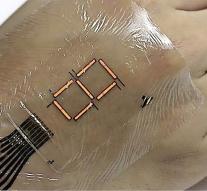

Display on the skin
tokyo - Watch TV on your skin. In the future it may be possible. The University of Tokyo is engaged in the development of electronic skin showing his images.
Everywhere in the world working on this so-called 'e-skin' but the Japanese are the first to come out with a working piece material. Earlier experiments ran aground because the skin is not flexible enough or too thick so it feels uncomfortable.
The Japanese invention under the supervision of Professors Takao Someya and Tomoyuki Yokota consists of a layer of organic material (Parylene) and non-organic material (Silicon Oxynitrite). By the addition of an extremely thin layer of metal can be screened image. The breakthrough lies partly in the metal needed not exposed to the air for the screen because exposure to air is bad for the quality of the metal.
The e-skin is extremely thin, only 3 micrometer. In comparison, a normal human hair, is 40 micrometers thick. It is therefore much thinner than normal skin and has little weight. Because of the great flexibility it can follow the movements of the body and the muscles exactly. Also, this flexibility is a breakthrough.
The first ideas to use the material, are in the medical field. For example, a piece of e-skin could serve to indicate how high the heart rate or to indicate that the carrier should have a drink.
Koen Kas, Belgian professor of oncology and a renowned expert on the technical developments in healthcare, sees a big future for this technology. 'An important step is to not only collect data about the body, but also to give personal guidance based on the data,' he explains in the Belgian De Tijd.
At the presentation, the University of Tokyo has shown a simple example showing the e-skin one digit. However, expectations are high, because the e-skin can eventually function as a true display that replaces the smartphone screen.
Professor Someya compares developments with the advent of the smartphone: 'The mobile phone has changed the way we communicate has changed. But even though the devices are getting smaller, we should always take it. How does the world look like if we can fix the display on our bodies? '
The e-skin falls into the category dermables; a technique that the successor to the so-called wearables, such as the straps around the wrist to measure many things about health. From using dermables in the medical sector is widely expected. There have been patches on the market that do messages via a connected mobile phone, for example blood pressure. The great advantage of the dermables to the wearables is that the user does not need to carry. The piece of e-skin or the patch is stuck and then everything goes without saying.
Moreover, with the development of e-skin still not solved all the problems. The Japanese researchers now want to further problems as the supply of current to the display on the skin works and an antenna so that for example a YouTube video can be retrieved.


Leave a comment